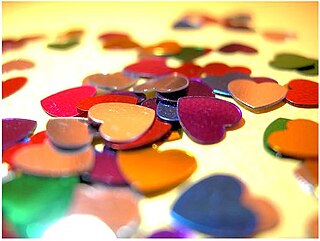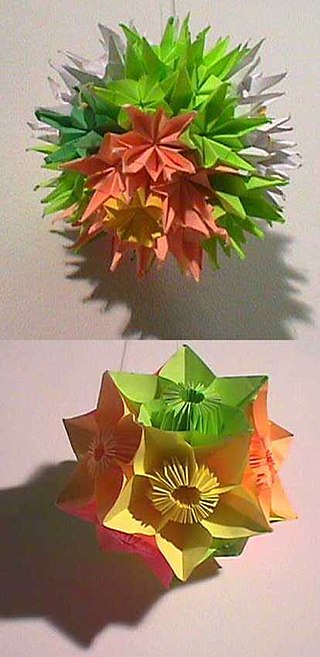Streamer or streamers may refer to:

Wallpaper is a material used in interior decoration to decorate the interior walls of domestic and public buildings. It is usually sold in rolls and is applied onto a wall using wallpaper paste. Wallpapers can come plain as "lining paper", textured, with a regular repeating pattern design, or, much less commonly today, with a single non-repeating large design carried over a set of sheets. The smallest rectangle that can be tiled to form the whole pattern is known as the pattern repeat.

A paper machine is an industrial machine which is used in the pulp and paper industry to create paper in large quantities at high speed. Modern paper-making machines are based on the principles of the Fourdrinier Machine, which uses a moving woven mesh to create a continuous paper web by filtering out the fibres held in a paper stock and producing a continuously moving wet mat of fibre. This is dried in the machine to produce a strong paper web.

Upholstery is the work of providing furniture, especially seats, with padding, springs, webbing, and fabric or leather covers. The word also refers to the materials used to upholster something.

Confetti are small pieces or streamers of paper, mylar, or metallic material which are usually thrown at celebrations, especially parades and weddings. The origins are from the Latin confectum, with confetti the plural of Italian confetto, small sweet. Modern paper confetti trace back to symbolic rituals of tossing grains and sweets during special occasions, traditional for numerous cultures throughout history as an ancient custom dating back to pagan times, but adapted from sweets and grains to paper through the centuries. Confetti are manufactured in multiple colors, and commercially available confetti come in many different shapes. A distinction is made between confetti and glitter; glitter is smaller than confetti and is universally shiny. Most table confetti are also shiny. While they are called metallic confetti they are actually metallized PVC. The most popular shape is the star. Seasonally, Snowflake Confetti are the most requested shape. Most party supply stores carry paper and metallic confetti. Confetti are commonly used at social gatherings such as parties, weddings, and Bar Mitzvahs. The simplest confetti are simply shredded paper, and can be made with scissors or a paper shredder. Chads punched out of scrap paper are also common. A hole punch makes small round chads, and a ticket punch makes more elaborate chads. Most pieces of paper flats will flutter as tumblewings giving long flight times.

In wrestling, a pin is achieved by holding an opponent's shoulders to the mat for a three count. Pinfall is the term used in professional wrestling which is a way to win the match for that person or team.

A cap gun, cap pistol, or cap rifle is a toy gun that creates a loud sound simulating a gunshot and smoke when a small percussion cap is ignited. Cap guns were originally made of cast iron, but after World War II were made of zinc alloy, and most newer models are made of plastic. Cap guns get their name from the small discs of shock-sensitive explosive compounds that provide the noise and smoke, effectively the same as the Maynard tape primer and percussion caps used in real firearms of the mid to late 1800s but usually smaller and made from cheap plastic or paper. Some are arranged in plastic rings of eight or twelve. There are also single caps, roll caps, disk caps, and cap strips all of which are actually extremely small versions of percussion fireworks. Armstrong's mixture is often used today as the explosive, but previously the tiny powder charge was a simple mixture of potassium perchlorate, sulfur, and antimony sulfide sandwiched between two paper layers that hold in the gases long enough to give a sound report when the cap is struck.

Glass bead making has long traditions, with the oldest known beads dating over 3,000 years. Glass beads have been dated back to at least Roman times. Perhaps the earliest glass-like beads were Egyptian faience beads, a form of clay bead with a self-forming vitreous coating. Glass beads are significant in archaeology because the presence of glass beads often indicate that there was trade and that the bead making technology was being spread. In addition, the composition of the glass beads could be analyzed and help archaeologists understand the sources of the beads.

A barrel roll is an aerial maneuver in which an airplane makes a complete rotation on both its longitudinal and lateral axes, causing it to follow a helical path, approximately maintaining its original direction. It is sometimes described as a "combination of a loop and a roll". The g-force is kept positive on the object throughout the maneuver, commonly between 2 and 3g, and no less than 0.5g. The barrel roll is commonly confused with an aileron roll.

In metalworking, rolling is a metal forming process in which metal stock is passed through one or more pairs of rolls to reduce the thickness, to make the thickness uniform, and/or to impart a desired mechanical property. The concept is similar to the rolling of dough. Rolling is classified according to the temperature of the metal rolled. If the temperature of the metal is above its recrystallization temperature, then the process is known as hot rolling. If the temperature of the metal is below its recrystallization temperature, the process is known as cold rolling. In terms of usage, hot rolling processes more tonnage than any other manufacturing process, and cold rolling processes the most tonnage out of all cold working processes. Roll stands holding pairs of rolls are grouped together into rolling mills that can quickly process metal, typically steel, into products such as structural steel, bar stock, and rails. Most steel mills have rolling mill divisions that convert the semi-finished casting products into finished products.

The Japanese kusudama is a paper model that is usually created by sewing multiple identical pyramidal units together using underlying geometric principles to form a spherical shape. Alternately the individual components may be glued together. Occasionally, a tassel is attached to the bottom for decoration.
The scissors is an aerial dogfighting maneuver commonly used by military fighter pilots. It is primarily a defensive maneuver, used by an aircraft that is under attack. It consists of a series of short turns towards the attacking aircraft, slowing with each turn, in the hopes of forcing the attacker to overshoot. Performed properly, it can cause the attacking aircraft to move far enough in front to allow the defender to turn the tables and attack.

An arcus cloud is a low, horizontal cloud formation, usually appearing as an accessory cloud to a cumulonimbus. Roll clouds and shelf clouds are the two main types of arcus clouds. They most frequently form along the leading edge or gust fronts of thunderstorms; some of the most dramatic arcus formations mark the gust fronts of derecho-producing convective systems. Roll clouds may also arise in the absence of thunderstorms, forming along the shallow cold air currents of some sea breeze boundaries and cold fronts.

In glassblowing, cane refers to rods of glass with color; these rods can be simple, containing a single color, or they can be complex and contain strands of one or several colors in pattern. Caneworking refers to the process of making cane, and also to the use of pieces of cane, lengthwise, in the blowing process to add intricate, often spiral, patterns and stripes to vessels or other blown glass objects. Cane is also used to make murrine, thin discs cut from the cane in cross-section that are also added to blown or hot-worked objects. A particular form of murrine glasswork is millefiori, in which many murrine with a flower-like or star-shaped cross-section are included in a blown glass piece.

A kayak roll is the act of righting a capsized kayak by use of body motion and/or a paddle. Typically this is done by lifting the torso towards the surface, flicking the hips to right the kayak, and applying a small force by means of the paddle to assist the torso back over the boat.

A party popper is a handheld pyrotechnic device commonly used at parties. It emits a loud popping noise by means of a small friction-actuated explosive charge that is activated by pulling a string. The explosive charge comes from a very small amount of Armstrong's mixture in the neck of the bottle-like shape. In some party poppers, the explosive charge is replaced by compressed air. In party poppers with an explosive charge, there are less than 0.25 grains (0.016 g) of explosive. The streamers are non-flammable for safe use. The charge or compressed air blows out some confetti or streamers and emits a popping sound. The charge is often composed of red phosphorus and strong oxidizer, such as potassium chlorate and potassium perchlorate.
3D Aerobatics or 3D flying is a form of flying using flying aircraft to perform specific aerial maneuvers. They are usually performed when the aircraft had been intentionally placed in a stalled position.

Stir-fried ice cream, also known as rolled ice cream, is a sweetened frozen dessert. It is made using milk, cream and sugars as well as other added ingredients to improve the flavor. The liquid mixture is stirred to incorporate air spaces on an ice pan and simultaneously cooled to −30 °C (−22 °F). The completed rolling process results in rolls of smooth, semisolid ice cream or gelato. The rolls are placed in a vertical position in an ice cream cup, topped off with various toppings and decorations, and eaten with a spoon.

Saturday Mash-Up! is a British Saturday morning children's magazine entertainment programme on CBBC and BBC Two, first broadcast on 30 September 2017. It is currently presented by Joe Tasker and a puppet monster called Stanley performed by Dave Chapman.

A tandem rolling mill is a rolling mill with two or more close-coupled stands, where the reduction is achieved by the inter-stand tension(s) and the compressive force between the work rolls.

















